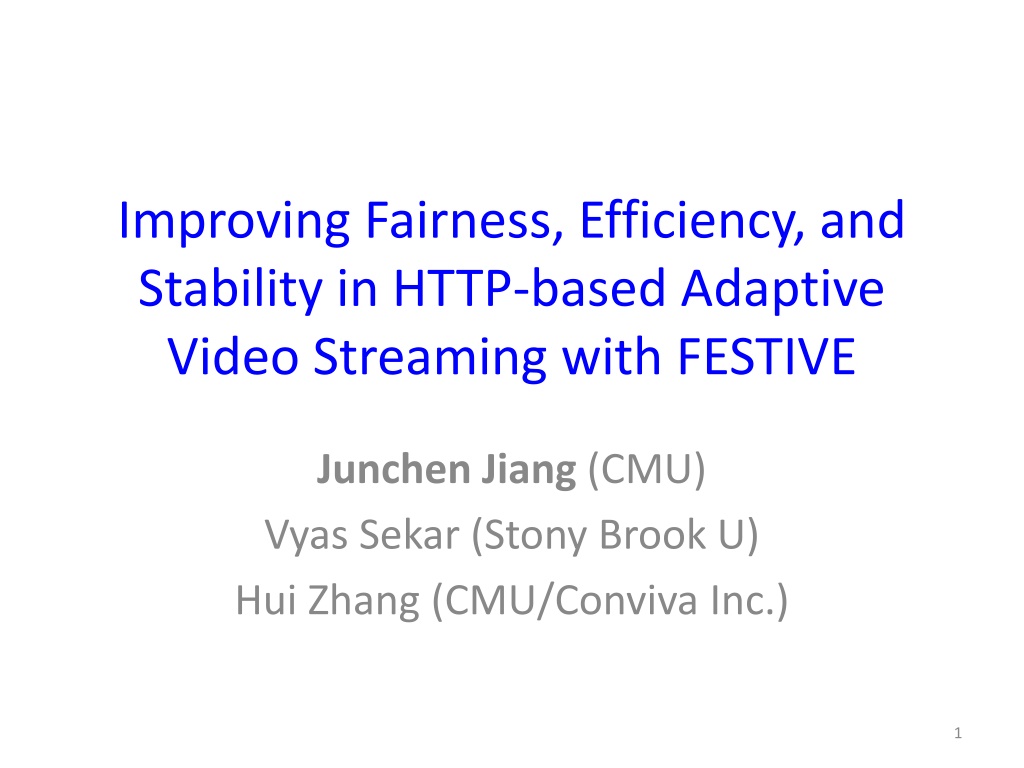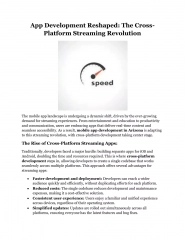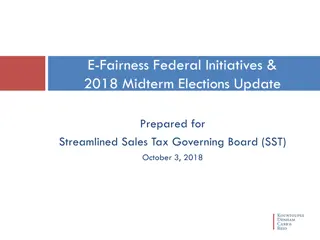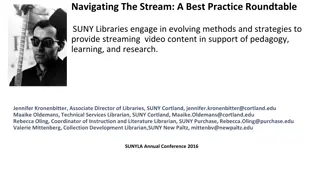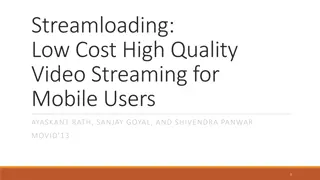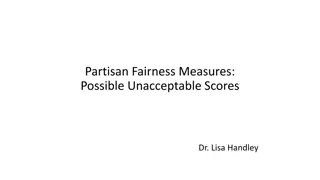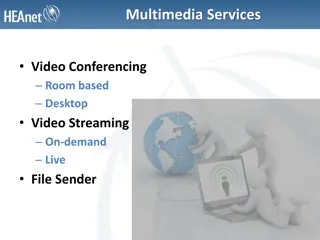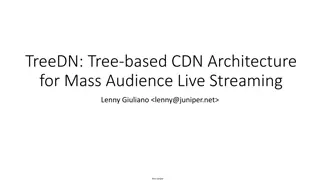Enhancing Video Streaming with FESTIVE: Fairness, Efficiency, and Stability
This research focuses on enhancing HTTP-based adaptive video streaming utilizing FESTIVE, developed by Junchen Jiang, Vyas Sekar, and Hui Zhang. With video traffic dominating the internet, the need for bitrate adaptation is crucial for ensuring video quality, reducing inefficiency, unfairness among users, and instability in switches. The study evaluates the metrics of goodness in video streaming, highlighting the challenges faced by state-of-the-art players like SmoothStreaming. Overcoming limitations such as limited control and feedback, FESTIVE aims to improve the overall video streaming experience.
Download Presentation

Please find below an Image/Link to download the presentation.
The content on the website is provided AS IS for your information and personal use only. It may not be sold, licensed, or shared on other websites without obtaining consent from the author. Download presentation by click this link. If you encounter any issues during the download, it is possible that the publisher has removed the file from their server.
E N D
Presentation Transcript
Improving Fairness, Efficiency, and Stability in HTTP-based Adaptive Video Streaming with FESTIVE Junchen Jiang (CMU) Vyas Sekar (Stony Brook U) Hui Zhang (CMU/Conviva Inc.) 1
Video Traffic is Becoming Dominant 2011, 66+% of Internet traffic is video. [Akamai] 2016, 86% will be video traffic. [Cisco] The Internet is becoming a Video Network 2
Background: HTTP-based Video 2nd Chunk in bitrate A A2 Client A1 A1 A2 A1 B1 A1 A2 HTTP Adaptive Player HTTP GET A1 B1 B2 Cache B1 B2 Web server Web browser Web server HTTP HTTP TCP TCP Server Why HTTP? Use existing CDN, Stateless server, NAT/firewall traversal 3
The Need for Bitrate Adaptation? Video quality matters [sigcomm11] Significant variability of intra-session bandwidth [sigcomm12] Bitrate adaptation offers a trade-off between high bitrate, low join time and buffering ratio. 4
Three Metrics of Goodness Inefficiency: Fraction of bandwidth not being used or overused Unfairness: Discrepancy of bitrates used by multiple players Instability: The frequency and magnitude of recent switches Bitrate (Mbps) 1.3 Bottleneck b/w 2Mbps Player A 0.7 time Bitrate (Mbps) Player B 0.7 5 time
Real World: SmoothStreaming Setup: total b/w 3Mbps, three SmoothStreaming players Player A Player B Player C Visually, SmoothStreaming performs bad. 6
How Do State-of-Art Players Perform? SmoothStreaming (SS) Adobe Akamai Netflix Instability index Unfairness index Inefficiency index SmoothStreaming (SS) appears to be better than other players. 7
Why it is Hard? Limited control Overlaid on HTTP Constrained by browser sandbox Limited feedback No packet level feedback, only throughput Local view Client-driven adaptation Independent control loop 8
Our Work Understand the root causes of these problems How can we fix these ? Within constraints of HTTP-based video Solution: FESTIVE (Fair, Efficient and Stable AdapTIVE) Outperforms industry-standard players in all three metrics! 9
Roadmap Motivation Design Abstract player model Chunk scheduling Bitrate selection Stateful algorithm Damping update Bandwidth estimation Evaluation Summary 10
Abstract Player Model B/W Bitrate Selection Chunk Scheduling Video Player Estimation Throughput of a chunk Bitrate of next chunk When to request GET HTTP Internet Chunk 1. Three components 2. Feedback loop between player and the network 11
Today: Periodic Chunk Scheduling Many players use this to keep fixed video buffer e.g., if chunk duration = 2 sec, chunk requests at T= 0,2,4, sec Example setup: Total bandwidth: 2Mbps Bitrate 0.5 Mbps, 2 sec chunks Chunk size: 0.5 Mbps x 2 sec = 1.0Mb b/w (Mbps) 2 1 Throughput: 2 Mbps 1 sec 1 sec 1 sec 0.5 sec 0.5 sec 1 sec Throughput: 1 Mbps 0 2s 1s time Throughput: 1 Mbps Player C T=1,3,5, Player A, T=0,2,4, Player B T=0,2,4, Unfair! Start time impacts observed throughput NOT a TCP problem! 12
Solution: Randomized Scheduling Request with a randomized interval 3 players: Bitrate 0.5 Mbps, 2 sec chunks b/w (Mbps) Throughput: ~1.3 Mbps 2 1 0 Throughput: ~1.3 Mbps Throughput: ~1.3 Mbps time 1s 2s Player C Player A Player B Intuition: fair chance to see each other. 13
Todays Bitrate Selection Strawman: Bitrate = f (observed throughput) Example setup: Total bandwidth 2Mbps Player A: 0.7 Mbps, Player B: 0.3 Mbps, Player C: 0.3 Mbps b/w (Mbps) 2 Throughput: ~1.6 Mbps 1 0.6 0 Throughput: ~1.1 Mbps Throughput: ~1.1 Mbps time Player C Player A Player B Unfair! Bitrate impacts observed throughput. Biased feedback loop implies unfairness 14
Solution: Stateful Bitrate Selection Intuition: Compensate for the bias! Check if in increase phase -- stateful. Lower bitrate player ramps up more quickly. Bitrate Player A Player B Time 15
FESTIVE Overall Design Video Player B/W Estimation Bitrate Selection Chunk Scheduling Stateful selection Randomized scheduling Harmoni c mean Delayed update When to request Bitrate of next chunk Throughput of a chunk GET HTTP 16
Roadmap Motivation Design Evaluation Methodology Robustness Summary 17
Methodology Real player + Local Ethernet (SmoothStreaming) Emulated algorithm + Local Ethernet A conservative approximation. Real player + real Internet (Adobe, Netflix) FESTIVE + Local Ethernet 18
Result with SmoothStreaming FESTIVE + Ethernet Emulated + Ethernet Real player + real Internet Real player + Ethernet Unfairness index Inefficiency index Instability index Festive is better than state-of-art on all metrics! 19
Comparison with Netflix FESTIVE w. Ethernet Emulated + Ethernet Real player w. real Internet Unfairness index Inefficiency index Instability index FESTIVE is consistently better. 20 20
Instability vs. Number of Players Bottleneck link: 10Mbps 1. Festive is more robust as number of players increases 2. Interesting artifacts of bitrate discreteness 21
Conclusion Video delivery architecture Stateful client, stateless server, data unit HTTP Robust design is critical for video Three key metrics: Fairness, Efficiency, Stability Why is this hard? Sandboxed environment, too coarse-grained Biased and limited feedback loops Our solution: FESTIVE Outperfoms all state-of-art algorithms 22
